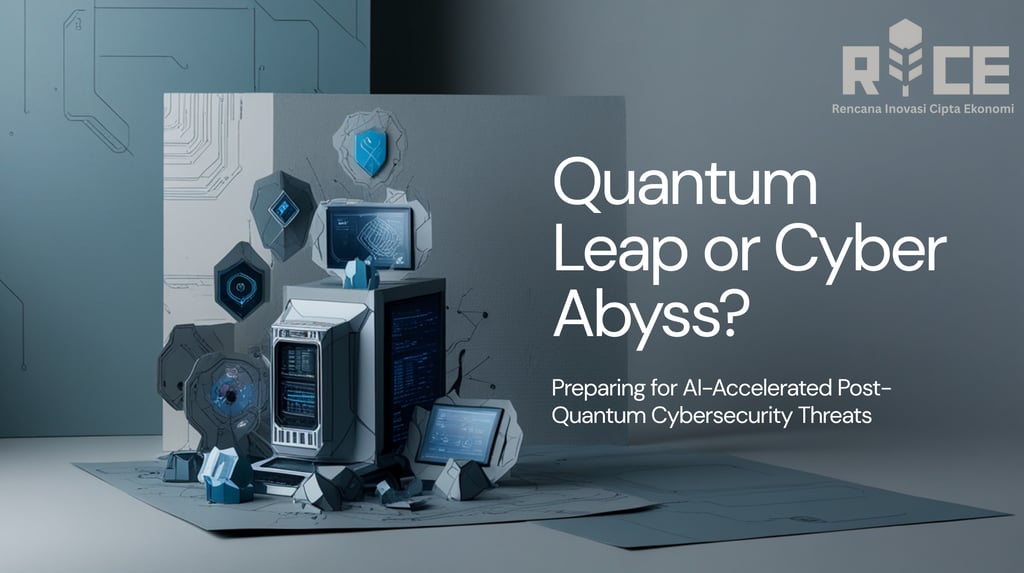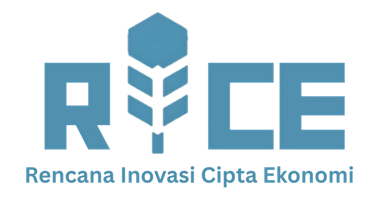Quantum Leap or Cyber Abyss? Preparing for AI-Accelerated Post-Quantum Cybersecurity Threats
Learn about PQC strategies, AI's dual role, and essential steps to secure your digital future against imminent quantum threats.
TECHNOLOGY
Rice AI (Ratna)
10/7/20259 min read


The digital landscape stands on the precipice of a monumental shift, driven by the dual forces of artificial intelligence (AI) and quantum computing. This convergence presents a paradox: unprecedented opportunities for innovation alongside existential threats to our current cybersecurity paradigms. For industry experts and professionals, understanding this evolving frontier is not merely academic; it is mission-critical for safeguarding organizational integrity and national security. The era where data encrypted today can be decrypted tomorrow by a quantum machine, potentially aided by sophisticated AI, is no longer a distant theoretical concern but an urgent reality demanding immediate strategic action.
Current cryptographic standards, the bedrock of digital trust, are fundamentally vulnerable to the immense computational power of future quantum computers. Simultaneously, advanced AI is rapidly accelerating both the sophistication of cyberattacks and the capabilities of defensive measures. Navigating this complex intersection requires a proactive, multi-faceted approach focused on building robust, quantum-resistant defenses. Our journey into this future begins with understanding the imminent quantum threat and how AI both exacerbates and offers solutions to this looming challenge.
The Imminent Quantum Threat to Classical Cryptography
The foundation of today's secure communications relies heavily on cryptographic algorithms that are computationally infeasible for classical computers to break. However, this foundational security is teetering on the edge of obsolescence in the face of quantum computing's transformative power. The sheer scale of processing power promised by quantum machines threatens to unravel the very fabric of our digital trust.
Shor's and Grover's Algorithms: The Game Changers
At the heart of the quantum threat lie specific quantum algorithms, most notably Shor's and Grover's. Shor's algorithm, discovered by Peter Shor in 1994, fundamentally threatens public-key cryptography. It can efficiently factor large numbers and solve discrete logarithm problems, which are the mathematical underpinnings of widely used encryption schemes like RSA and Elliptic Curve Cryptography (ECC). These algorithms secure everything from web browsing (HTTPS) to financial transactions and secure government communications. A sufficiently powerful quantum computer running Shor's algorithm could decrypt vast amounts of currently protected data, rendering it exposed.
Grover's algorithm, while less catastrophic than Shor's, offers a quadratic speedup for searching unsorted databases. In the context of cybersecurity, this means it could significantly reduce the time needed to break symmetric-key encryption algorithms (like AES) through brute-force attacks. While AES-256 might require a key length adjustment rather than a complete overhaul, the impact on key exchange protocols and digital signatures is profound. The threat is compounded by the "Harvest Now, Decrypt Later" strategy, where adversaries collect encrypted data today, anticipating its decryption once quantum computers become powerful enough. This means even data protected with current encryption, if captured now, could be compromised in the future, especially sensitive long-lived data.
The Race to Quantum Supremacy
The global race for quantum supremacy is intensifying, with nations and major technology companies pouring billions into research and development. Governments understand that whoever achieves a fault-tolerant quantum computer first will possess an unparalleled advantage in intelligence, defense, and economic power. This competitive landscape means that the arrival of a "cryptographically relevant quantum computer" (CRQC) is not a distant science fiction scenario but an active pursuit, with varying expert predictions placing its arrival within the next decade or two.
This timeline is crucial for organizations, as the migration to quantum-resistant cryptography is not an overnight process. It requires years of planning, implementation, and testing across complex IT infrastructures. The security of data with a long shelf life, such as intellectual property, medical records, or classified government information, is particularly at risk. proactive measures must be taken now to ensure that data remains secure for its entire lifecycle, well into the quantum era.
AI: Fueling the Fire and Forging the Shield
Artificial intelligence, with its ability to process vast datasets and learn complex patterns, is a double-edged sword in the context of post-quantum cybersecurity. It can supercharge offensive capabilities, making attacks more potent and efficient, but it also provides a powerful suite of tools for defense, offering a potential counterbalance to emerging threats.
AI's Role in Accelerating Cyber Attacks
The sophistication of cyberattacks is escalating, largely due to the integration of AI and machine learning. Threat actors are leveraging AI to automate and optimize every stage of the attack lifecycle, creating an adversarial landscape that is dynamic and incredibly challenging to defend against.
# AI-Powered Attack Vectors
AI can significantly enhance traditional attack vectors and enable entirely new forms of assault. For instance, AI algorithms can optimize malware, allowing it to adapt to defensive measures, evade detection, and propagate more effectively. In phishing campaigns, generative AI can craft highly convincing emails, messages, and even deepfake voice or video calls, making social engineering attacks incredibly difficult for humans to discern. AI can also be used to scan for and exploit zero-day vulnerabilities at unprecedented speeds, identifying weaknesses in software before developers even know they exist. Furthermore, AI-driven reconnaissance can map network topologies, identify critical assets, and predict human behaviors with a precision that far surpasses manual efforts, providing attackers with a strategic advantage.
# The Adversarial AI Landscape
The emergence of adversarial AI means that machine learning models are not just being used by attackers but are also being targeted. Attackers can manipulate AI systems by feeding them corrupted data or adversarial examples, causing them to make incorrect predictions or bypass security controls. This presents a unique challenge for AI-driven defense systems, as they must be robust enough to withstand such sophisticated tampering. The sheer speed and scale at which AI can operate mean that threat detection and response systems must also be AI-accelerated to keep pace. The traditional "human in the loop" model, while still vital for decision-making, simply cannot react fast enough to mitigate AI-driven threats without significant automation.
AI as a Critical Defense Mechanism
While AI amplifies the offensive capabilities of adversaries, it is equally indispensable in building robust defenses against both classical and quantum-accelerated threats. Its ability to analyze vast amounts of data, detect anomalies, and automate responses makes it a cornerstone of modern cybersecurity.
# Proactive AI-Driven Cybersecurity
AI excels at proactive threat detection and anomaly identification. Machine learning models can analyze network traffic, user behavior, and system logs in real-time to identify deviations from normal patterns, often spotting nascent threats before they can escalate. This includes detecting polymorphic malware, identifying insider threats, and flagging unusual access attempts. Beyond detection, AI can power automated incident response, orchestrating immediate containment, isolation, and remediation actions. This drastically reduces the time between detection and response, minimizing the damage potential of an attack.
# The Symbiotic Relationship: PQC and AI Defense
The transition to Post-Quantum Cryptography (PQC) is a monumental task, and AI can play a critical role in facilitating this migration. AI tools can assist organizations in inventorying their cryptographic assets, mapping dependencies, and identifying areas of highest quantum risk. By analyzing codebases and network configurations, AI can pinpoint where cryptographic primitives are used and help prioritize systems for PQC migration. Furthermore, AI can monitor the cryptographic agility of systems, ensuring that they can smoothly transition between algorithms as new PQC standards emerge. This symbiotic relationship—AI identifying vulnerabilities and managing the PQC transition, while also defending against AI-accelerated attacks—is essential for building truly quantum-resilient cyber defenses. (Internal Link Suggestion: Link to a Rice AI blog post on AI for threat intelligence.)
Navigating the Quantum-Safe Transition
The transition to quantum-safe cryptography is not a switch but a journey requiring careful planning, significant investment, and a strategic approach. It demands a fundamental shift in how organizations perceive and manage their cryptographic infrastructure.
Embracing Post-Quantum Cryptography (PQC)
The development of Post-Quantum Cryptography (PQC) is the global community's answer to the quantum threat. These are new cryptographic algorithms designed to be resistant to attacks by both classical and quantum computers.
# The PQC Landscape: Algorithms and Standards
Various mathematical approaches are being explored for PQC, each with its strengths and weaknesses. These include lattice-based cryptography, code-based cryptography, hash-based cryptography, and multivariate polynomial cryptography. The U.S. National Institute of Standards and Technology (NIST) has been leading a multi-year effort to standardize PQC algorithms, which is a critical step towards widespread adoption. As of its latest announcements, NIST has selected several algorithms, such as CRYSTALS-Kyber for key establishment and CRYSTALS-Dilithium for digital signatures, as primary candidates for standardization. Organizations must begin familiarizing themselves with these new primitives and understanding their computational requirements and security properties.
# Cryptographic Agility: The New Imperative
Given the evolving nature of quantum computing and PQC research, it is highly probable that the "final" set of quantum-safe algorithms may change or be refined over time. This uncertainty underscores the importance of cryptographic agility. Organizations must design and implement systems that can easily swap out cryptographic primitives without requiring a complete overhaul of the underlying infrastructure. This means abstracting cryptographic functions from applications and infrastructure, enabling flexible updates. Hybrid modes, where classical and PQC algorithms are used in parallel, serve as a pragmatic interim solution, offering dual protection during the transition phase and allowing for real-world testing of PQC implementations.
A Strategic Approach to Post-Quantum Migration
A successful PQC migration strategy is built on a series of carefully executed steps, starting with thorough assessment and moving towards phased implementation.
# Inventory and Risk Assessment
The first critical step for any organization is to conduct a comprehensive inventory of all cryptographic assets. This includes identifying every instance where cryptography is used, from network protocols (VPNs, TLS/SSL) to data at rest (disk encryption, database encryption) and digital signatures. It's crucial to understand what data is being protected, its sensitivity, and its required longevity. Data that needs to remain confidential for decades (e.g., medical records, intellectual property, national secrets) must be prioritized for quantum-safe migration. This assessment helps determine the "cryptographic attack surface" and where quantum vulnerabilities pose the greatest risk.
# Pilot Programs and Vendor Collaboration
Engaging with cybersecurity vendors, especially those specializing in PQC solutions, is vital. Many vendors are already developing quantum-resistant products and services, from PQC-enabled hardware security modules (HSMs) to quantum-safe communication protocols. Organizations should begin conducting pilot programs, testing PQC algorithms and solutions in non-production environments. These pilots provide invaluable real-world experience, helping to identify performance implications, integration challenges, and potential interoperability issues before widespread deployment. Collaboration with industry peers and participation in relevant forums can also provide insights and shared best practices for navigating this complex transition.
Fortifying Your Digital Future with Rice AI
In this dynamic and challenging cybersecurity landscape, proactive expertise is not just beneficial; it is essential. At Rice AI, we specialize in providing the cutting-edge AI-driven cybersecurity solutions necessary to navigate the complexities of quantum threats and prepare for the PQC era. We understand that the convergence of AI and quantum computing presents both formidable risks and unprecedented opportunities for enhancing an organization's digital resilience.
Our comprehensive services are designed to address the full spectrum of post-quantum cybersecurity challenges. We offer tailored quantum readiness assessments that meticulously inventory your cryptographic footprint, identify critical vulnerabilities, and provide a clear roadmap for PQC migration. Leveraging our deep expertise in Artificial Intelligent Technology, Rice AI delivers AI-powered threat intelligence systems that can detect and predict advanced AI-accelerated attacks with superior accuracy and speed, helping you stay ahead of sophisticated adversaries.
Furthermore, Rice AI offers specialized consulting for PQC migration, guiding organizations through the selection, implementation, and testing of quantum-resistant algorithms and protocols. We assist in establishing cryptographic agility frameworks, ensuring your systems are adaptable to future cryptographic standards. Our solutions extend to robust cryptographic inventory management, ensuring you have complete visibility and control over your encryption posture. Partnering with Rice AI means you gain a trusted ally committed to fortifying your digital future. We provide the insights and tools to transform potential cyber abysses into strategic advantages, ensuring your organization is prepared for the quantum leap.
Charting a Secure Course Through the Quantum Era
The convergence of artificial intelligence and quantum computing marks an undeniable inflection point for cybersecurity. It presents a future where the computational power to break today's most robust encryption is within reach, a future further complicated by AI's capacity to accelerate both attack and defense strategies. The question is no longer if we need to prepare, but how decisively and how quickly we act. Inaction is not a neutral stance; it is a direct invitation for compromise. The "Harvest Now, Decrypt Later" threat is a real and present danger, actively putting long-lived sensitive data at risk right now.
Organizations must embark on a comprehensive journey toward quantum readiness without delay. This means prioritizing a thorough inventory of all cryptographic assets and conducting a rigorous risk assessment to understand the specific vulnerabilities to quantum attacks. Simultaneously, embracing Post-Quantum Cryptography (PQC) standards, as they emerge from bodies like NIST, is paramount. Building cryptographic agility into systems—the ability to easily swap out cryptographic primitives—will ensure adaptability as PQC algorithms mature and standards evolve.
Leveraging AI for defense is equally critical. AI-driven cybersecurity tools offer the speed and analytical depth required to counter AI-accelerated attacks, providing advanced threat detection, anomaly identification, and automated response capabilities. The synergy between AI-powered defenses and PQC implementation is the key to building truly resilient systems for the future.
The future of cybersecurity demands foresight, agility, and a robust strategy to navigate this complex landscape. By proactively planning for PQC migration, investing in advanced AI-driven defenses, and fostering cryptographic agility, organizations can transform potential threats into strategic advantages. Do not wait for the quantum computers to arrive; begin your quantum readiness journey today.
Call to Action: To understand your organization's specific quantum exposure and begin charting a secure path forward, contact Rice AI for a comprehensive quantum readiness assessment. Secure your digital future before it's too late.
#QuantumCybersecurity #AIinCybersecurity #PostQuantumCryptography #PQC #QuantumComputing #CyberThreats #DigitalSecurity #AIsecurity #QuantumReadiness #CryptographicAgility #CyberDefense #FutureOfSecurity #Infosec #TechTrends #RiceAI
RICE AI Consultant
To be the most trusted partner in digital transformation and AI innovation, helping organizations grow sustainably and create a better future.
Connect with us
Email: consultant@riceai.net
+62 822-2154-2090 (Marketing)
© 2025. All rights reserved.


+62 851-1748-1134 (Office)
IG: @riceai.consultant
